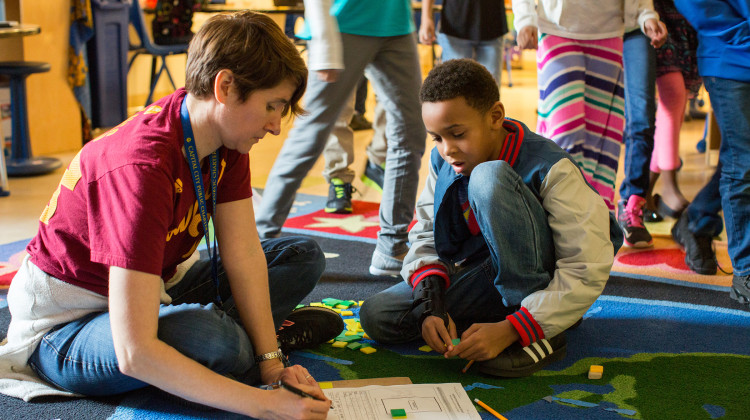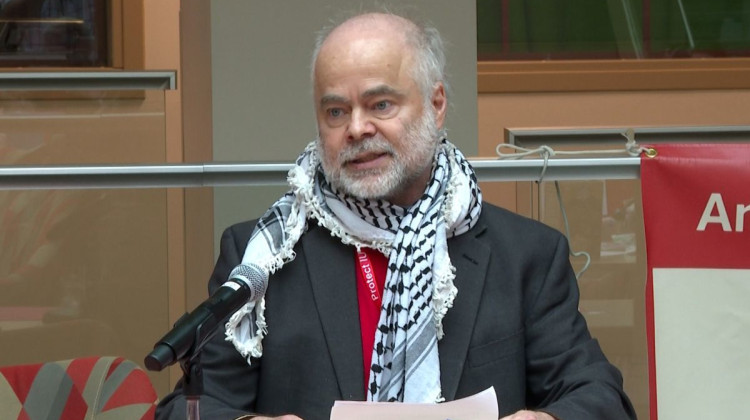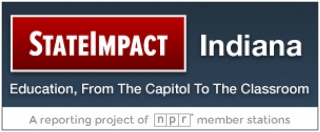
Katy Olson of Lafayette points out Machu Picchu on a map at IUPUI, where the state geographic bee was held in early April.
— Photo: Sarah Fentem
INDIANAPOLIS -- It’s a Friday morning at IUPUI, and about 20 middle-school kids are seated in the front of a second-floor classroom. They’re dressed up in their Sunday best — dresses, polos with starched collars — it’s a big day for them. Near the back of the room, parents outnumber the chairs two-to-one; many end up sitting on the floor.
These kids are all regional finalists for the state geographic bee, competing to represent Indiana at the big National Geographic bee in D.C. this May. But before they get there, they need to get out of this room and onto the big stage for finals, where the top ten will be whittled down to a single winner.
They’re all smart kids, adept at answering questions about cultural music in Malaysia and mountain ranges in Alaska. Most of them have another thing in common, too: More than 80 percent of the kids here are boys.
There are a few exceptions. Katy Olson, an eighth grader from East Tipp Middle School in Lafayette, is one of 18 girls among 101 qualifiers. She’s not exactly a geography nut, but she says she’s interested in learning about different places and cultures.
“I’m really interested in travel and I’ve been to a few different countries with my family,” she says, “I like learning about countries and how different the world is.”
The low percentage of girls at bees isn’t something new. Historically, both at the state and national levels, girls have rarely made up more than 20 percent of qualifiers at geographic bees.
“In the early nineties when people first started implementing state-level geographic bees or the national bees, everyone noticed, there’s no females!” says Kathy Kozenski, the executive director of the Geography Educators’ Network of Indiana (shortened to GENI, pronounced, “genie”).
Kozenski, who is the kind of person whose email signature contains the geographic coordinates of her office, says female representation in geographic bees is indicative of a larger trend of young girls’ lack of interest in the field. And ever since these bees’ inception, educators and researchers have been trying to parse out why.
One theory has to do with competition. Some girls, say experts, just aren’t as driven to compete, especially when they’re the only woman there.
The big theory, though, has to do with development of spatial intelligence…the bedrock of geographic knowledge. It’s built through exploration, says Kozenski.
“Young girls, toddlers through elementary schools, are more protected by adults,” Kozenski says. “So they’re not generally able to wander around their neighborhoods and backyards as much as young boys are given the permission to do that.”
Katy Olson from East Tipp says she’s outside of the norm. She’s from rural Tippecanoe County and enjoyed a lot of freedom.
“We live in the middle of the woods kind of, it’s still in the neighborhood, so I did a lot of exploring in there,” she says of her childhood.
A map at the Indiana state geographic bee showcases finalists from around the state. Only 18 of the 101 regional winners this year were female. — Photo: Sarah Fentem
She puts forth another reason: Girls are pulled in lots of different directions these days, she says. They’re encouraged to do lots of extracurriculars such dancing or music, and that means less free time to cultivate scientific interests.
“Girls might be pressured to do other things like cheer or focus on their academics or geography and stuff,” she says. “But they shouldn’t be afraid to do something that you’re interested in!”
Olson’s experienced this firsthand. She’s on her school’s dance team, something she says takes up a lot of her time.
Only two girls in the state bee’s nearly 30-year history have made it all the way to the top. One of these is Kellie Packwood, who just like Olson, grew up in rural Indiana, playing outside. Packwood still works in STEM. As a Texas-based software developer, she’s still often the only woman in a room full of men.
Growing up, Packwood was a geography nerd of the highest degree. She learned the world’s countries, then the country’s flags. When she ran out, she started making her own.
“I was making up countries in my backyard, all these countries and I had trade routes and EVERYTHING!” she says.
She says in STEM, failure happens before success, something that might prove discouraging to girls not historically socialized to value such pursuits. If we want more girls in science, she says, we also need to tell them it’s OK to fail, too.
“In socializing girls and women we tend to [say] ‘Oh, if at first you don’t succeed, you know, maybe this isn’t it for you,’” Packwood says. “I think women and girls are told this more often than boys.”
She says that takes self-esteem, an absolute requirement when it comes to getting girls into science.
So why do we need more women in geography?
“The value is perspective,” GENI’s Kozenski, who says science, and geography in particular, needs more women like Packwood and Olson. The discipline underlies so many different professions now, she says, from medicine and public health to infrastructure planning and marketing.
“The more people we have engaged in geographic thinking, looking at things and from a spatial perspective, the more solutions we can provide,” Kozenski says.

The 2016 Indiana geographic bee top ten finalists. — Photo: Sarah Fentem
There are good signs, she says. When the geographic bee first began in Indiana, the percentage of girls hovered around the 10 percent mark. These days, it’s nearly doubled. Additionally, Kozenski says as geographers head to college and grad school, the gender gap gets smaller, with university geography departments sporting a more even numbers of men and women.
Even so, this year, there wasn’t a single girl in the top ten.
OIson didn’t make it past the semifinals. To be fair, she got some really hard questions, like one about a drought in Yemen. But she says she hopes to take her interest with geography with her into the future. Hopefully when she gets there, she won’t be the only woman in the room.
 DONATE
DONATE








 Support WFYI. We can't do it without you.
Support WFYI. We can't do it without you.